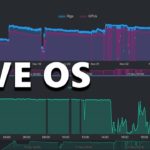A large part of the crypto community is impatiently looking forward to the next Bitcoin Halving. However, the point in time is not a fixed date, but is calculated, as with the recently successful Ethereum merge, from the blocks confirmed to date. That’s why Bitcoin says: The halving comes in 81,966 (as of 10/10/22, 3:53 p.m.) blocks.
This factor affects the halving
The recent increase in Bitcoin hash rate is an important component to determine the next adjustment. On average, a block is found every 10 minutes and the transactions it contains are fed into the network.
If the hash rate, i.e. the computing power of the network, increases, new blocks are validated more quickly. The problem: Last week, block 757,214 saw a new all-time high of 321.15 exahashes per second (EH/s). As a result, the average block time was undershot. According to calculations by Bitcoinsensus.com, the duration was then 7.65 minutes/block. Accordingly, the halving event had also been postponed to December 19, 2023.
Meanwhile, the “current block generation time” is 8.66 minutes, which has pushed the halving to February 2024. The last bitcoin is expected to be found in 2140. From then on, miners only receive the fees that network users pay to execute transactions. But how can that work if the hash rate is constantly increasing and the halving events are theoretically shorter and shorter?
Bitcoin fixes this!
Two words: Mining Difficulty. Of course, the great Satoshi Nakamoto thought of automatically adjusting the network. As new miners join the network, or an existing miner upgrades their hardware, the hash rate increases. The same happens with the Mining Difficulty – the difficulty increases the more is mined. Accordingly, the difficulty decreases in direct proportion when the hash rate of Bitcoin falls.
read too

So that the block time does not continue to shrink, the difficulty is automatically adjusted every 2016 blocks. This results in an average time of ten minutes. 2016 blocks equal approximately two weeks. These 14 days ended yesterday, October 9th. In line with the increased hash rate, the difficulty was also increased. At 35.61 T, it marks a new all-time high.
The last bitcoin halving
The halving takes place after 210,000 blocks and thus about every four years. The event supports the disinflationary supply structure behind Bitcoin – after all, there will be a maximum of 21 million Bitcoins.
In the past, the Bitcoin price has risen sharply after each halving. Although this has taken several months each time, the cryptocurrency’s market capitalization has spiraled to new highs after each halving. After the last adjustment, investors experienced new heights some time later.
The current developments on the market, but also the macroeconomic events, are currently clearly pointing to a bear market rally. It is unclear when the Bitcoin price in particular can break free from the months of stagnation. Many investors are sometimes of the opinion that only the next halving in 2024 will bring change.
It is extremely unlikely that the Bitcoin Halving could come months earlier or even in 2023. Although be almost 61 percent of the 210,000 blocks have already been mined, but the difficulty has increased as well. Sometimes you just have to wait and stack sats.
Do you want to buy cryptocurrencies?
Trade the most popular cryptocurrencies like Bitcoin and Ethereum with leverage on dYdX, the leading decentralized exchange for derivatives trading.
To the provider














